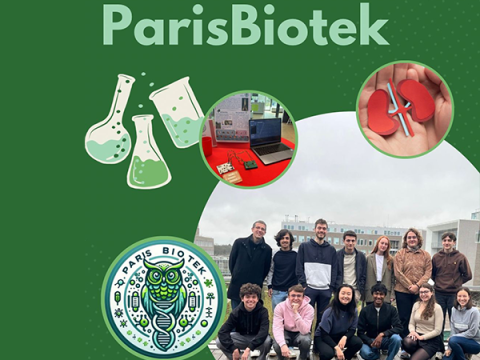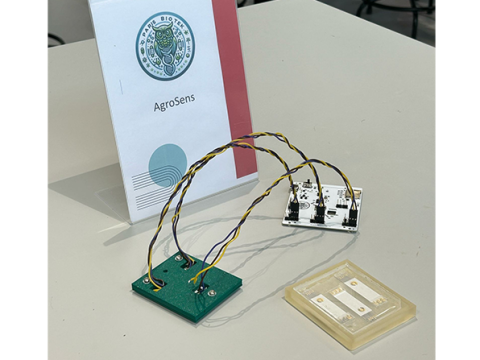
AgroSens, a connected sensor to monitor kidney failure
July 25 2025Fifteen students from AgroParisTech, CentraleSupélec, and ENS Paris-Saclay have designed a connected sensor to improve the daily lives of people with kidney failure. This innovation, which was conceived in the classroom, could change the lives of millions of patients with this disease. Interview with Guillaume Centene-Guglielmi and Eva Legrand, students at AgroParisTech.
An idea born from an international competition
The idea for this connected sensor began in 2022 when Lisa Schmitt, a student passionate about biotechnology, discovered SensUs, an international competition focused on developing biosensors for public health issues. That year, the challenge was creatinine, a key biomarker for monitoring kidney failure. She imagined a sensor capable of continuously measuring this marker, an innovative alternative to occasional blood tests. She founded the ParisBioTek association and put together an interdisciplinary team of students from AgroParisTech, CentraleSupélec, and ENS Paris-Saclay. Together, they embarked on the AgroSens adventure with a clear ambition: to put technology at the service of health, right from the school benches.
What issue are you addressing with this project?
Guillaume Centene-Guglielmi: Today, when you suffer from chronic kidney disease, you have to have regular blood tests and wait for the results. It’s not very practical. So we thought: what if we changed that? We’re working on a portable, connected sensor that continuously measures creatinine. The idea is to be able to detect warning signs in real time so that doctors can adjust treatments immediately and patients can regain some control over their health. Less waiting, more responsiveness, and above all, a real step forward in quality of life.
How did the team behind the project come together? What does your prototype look like?
Guillaume Centene-Guglielmi: From the outset, we knew we couldn’t build this sensor on our own. So we went looking for allies: CentraleSupélec for electronics, ENS Paris-Saclay for microfluidics, and of course AgroParisTech for all the biology and enzyme work. We put together a highly complementary team of 15 students, each with their own expertise. We meet every two weeks to review progress. The prototype is starting to look good. It’s an enzymatic sensor embedded in a microfluidic circuit, connected via Bluetooth to a mobile app. In practical terms, a sample of interstitial fluid or blood is placed on the chip. The sample passes through a detection zone, an electrode covered with an enzymatic gel, and the electrical signal generated is proportional to the creatinine level. The whole thing works on a small, autonomous electronic card that can be recharged via USB-C.
And today, where are you in the development process?
Guillaume Centene-Guglielmi: Last year was our first time participating, so we did a lot of exploring: bibliography, contacting experts, initial experiments… but we found ourselves a little behind as the competition approached. This year, we started earlier and we’re back with a killer plan. We’re capitalizing on the successful miniaturization and focusing on improving the enzyme signal. The goal is to increase precision, enhance reliability, and refine the application. We are improving the sensitivity and stability of the sensor, the ergonomics of the application, and we are working to make the measurements more reliable. The prototype is functional but still needs some work before the SensUs competition.

How did AgroParisTech and the Foundation support you?
Eva Legrand: We could never have gotten this far without support. The Foundation gave us two major boosts through the Creativity and Maturation juries: €500, then €5,000, and that changed everything. We were able to buy equipment, move forward with the prototype, and above all, work in real conditions. Our lab activities are supervised by Vincent Sauveplane. He gives us access to a workbench, equipment, and valuable advice. And then there was other key support: CentraleSupélec, ENS, Paris-Saclay University, the Haute-Joux Foundation… It’s a whole ecosystem that believed in us. And frankly, it gives us wings.
What happens after the competition?
Eva Legrand: We don’t plan on stopping there! Some want to continue in research, others are already dreaming of launching a start-up. The idea of a connected patch capable of continuously monitoring several blood parameters is seriously beginning to take shape… But beyond the sensor, this experience has given us a taste for innovation, for concrete results, for impact. We’ve realized that we can combine science, usefulness, and ambition. And that opens a lot of doors.
A word of encouragement for students who are hesitating to take the plunge?
Eva Legrand: Yes, it’s intense. Yes, it takes time, energy, and sometimes a bit of hard work. But you learn to work as a team, to turn an idea into a prototype, to pitch, to deal with the unexpected… and to bounce back when things go wrong. And above all, you realize that entrepreneurship and research are not worlds apart. It’s accessible. Even in your first year. So go for it!
Article written by Enzo Bertaut as part of his duties as a student ambassador for the Foundation.

